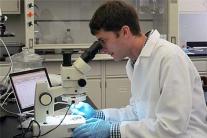KATC Meteorologist Jobie Lagrange visited Hamilton Hall to give a guest lecture about hurricanes for students in Int
Researchers trace carbon dioxide levels to prehistoric times
Tue, 05/12/2015 - 4:00amA new way to measure past levels of carbon dioxide in the Earth’s atmosphere may help scientists better understand how climate has changed over time.
It may also help them better predict how anticipated increases in carbon dioxide will affect climate.
“Our new method uses organic matter from dead terrestrial plants, similar to the coal we burn for energy, that is preserved in the geologic record as fossils, soils, and sediments,” said Dr. Brian Schubert, an assistant professor in the University of Louisiana at Lafayette’s School of Geosciences.
Findings of research conducted by Schubert and Dr. A. Hope Jahren, a professor at the University of Hawaii at Manoa, are published in the May issue of “Geology,” one of the most respected journals in that field.
Until now, scientists traced levels of carbon dioxide by studying ice-core records from Antarctica that date back 800,000 years.
But Schubert said the new method enables scientists to track carbon dioxide levels for more than 400 million years.
The key is what he describes as the “relative abundance” of two isotopes of carbon – carbon-12 and carbon-13 – that are used by plants during photosynthesis, which converts carbon dioxide and water into organic compounds. Those isotopes are affected by the carbon dioxide level in the atmosphere at the time plants are growing.
“Using this technique, we can better quantify carbon dioxide levels ever since the first forested ecosystems appeared on Earth and determine carbon dioxide levels during major mass extinction events, such as the extinction of dinosaurs,” he said.
Caption: Dr. Brian Schubert examines plant fossils under a microscope in the stable isotope laboratory at UL Lafayette. Measurement of carbon isotopes in fossils such as these can be used to determine past levels of carbon dioxide in the Earth’s atmosphere.

